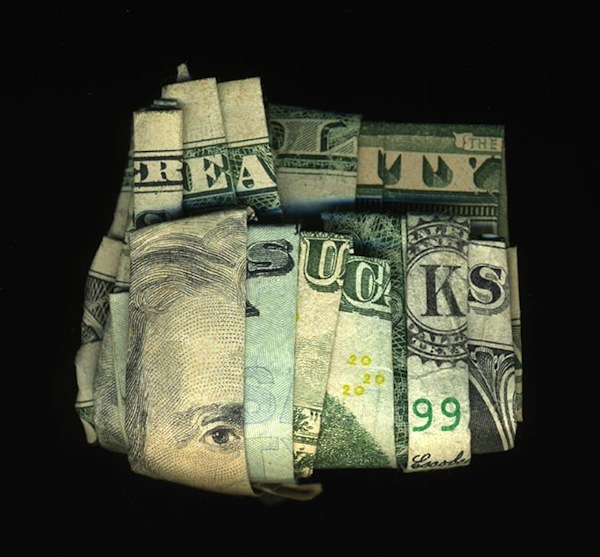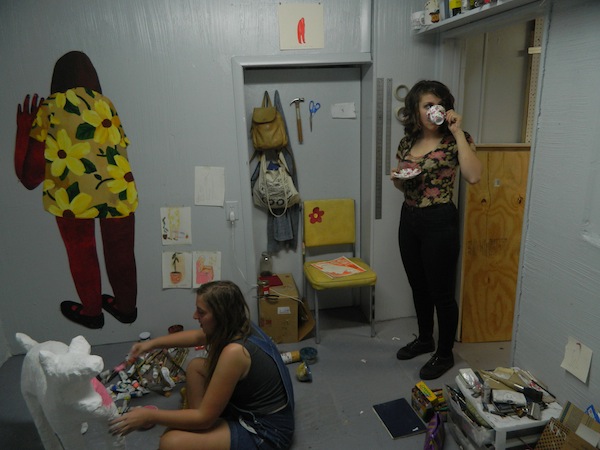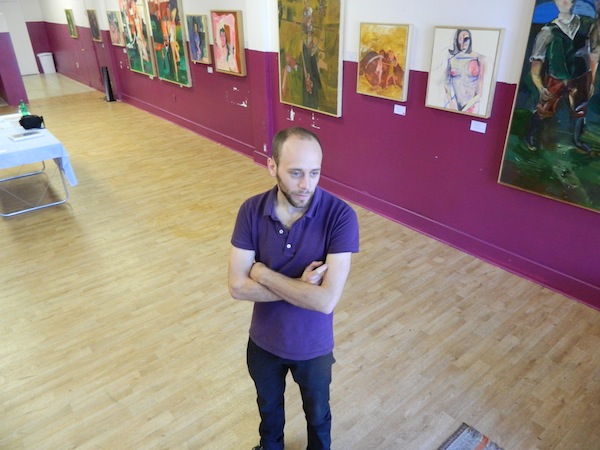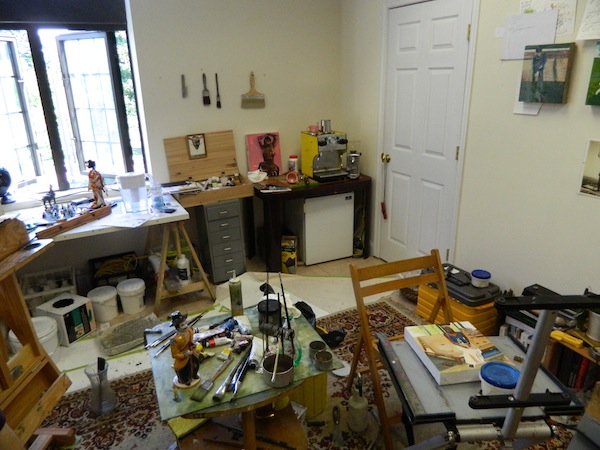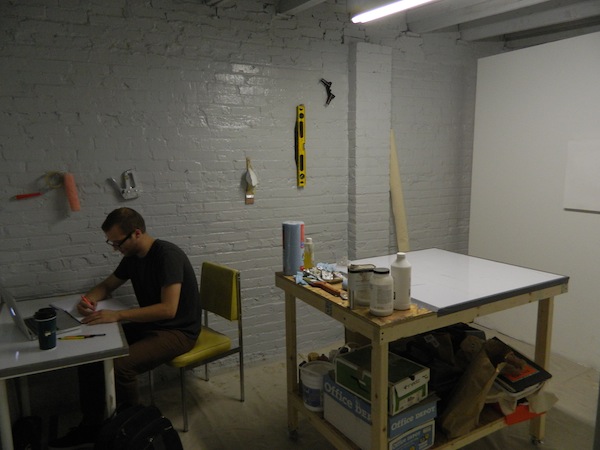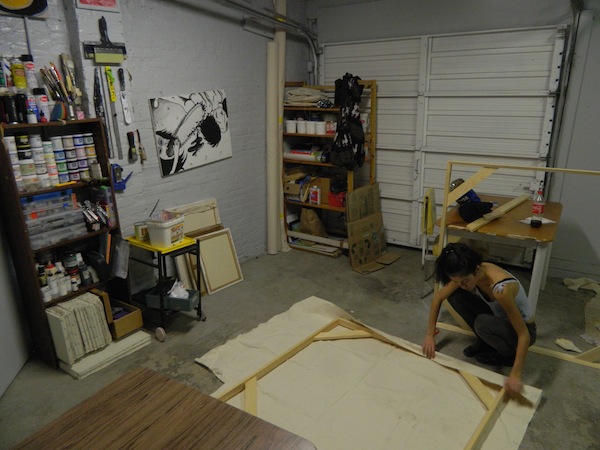Recently I visited Ariel Klein, an artist friend, in his studio in Silver Spring, Maryland. My intention was to view his new work from a recent show and to find out more about how he acquired his studio. His story was reported in a few different news sites lately, like the Washington Post and The Gazette, because of the unusual deal he was able to strike with his landlord. He ‘pays’ his rent by giving the landlord one painting a month.
For young artists, it is essential to develop strategies for creating our own personal workspaces, especially to overcome hurdles such as lack of funds, transitory living situations, and balancing that with a full time job. After graduating from MICA in 2012, I have found this issue to be of the utmost concern for many of my friends and fellow artists. Looking further, I have found the ways in which they’ve approached the issue to be as diverse as their work.
I arrived at Ariel’s studio around noon on a Wednesday with general questions about his work and studio. Klein’s space is located on the second floor of an office building off of Georgia Avenue, across from Montgomery College and Jessup Blair Park. Each of the suites within is rented out to different tenants and businesses. There are chairs in the hallway and paintings on the walls of the building, giving off the feeling of a doctor’s office. Klein’s studio is a small room, though this perception may be due to the fact that the space is filled to the brim with paintings and supplies. As we enter, there is a futon to our immediate left draped with a checkered blanket. There are books scattered throughout the room, mostly pertaining to art and painting techniques. There are two windows on the far wall and a large easel in the center of the room. Paintings and studies dot the walls of the room.
Technique is of major importance to Klein, developed during his yearlong residency in Spain at the University of Madrid School of Fine Art, in combination with his training at MICA. We get into a discussion of the mixing one’s own paints as described by one of his professors in Spain. I ask him about his new paintings which are generally smaller in stature than the ones he produced in school, though much more dense in compositionally.
Klein has always insisted on painting from life and the couch that I mention earlier is commonly used as a model stand. Klein likes to get acquainted with those in his immediate surroundings and have them pose as models for him and a certain type of social interaction is important to his work. Klein has set up is studio in such a way that his needs for social interaction can be met as well as the privacy necessary to complete the work of the artists. His studio is beside a restaurant and a barbershop and this affords Klein the opportunity to interact with many different people on a daily basis, which is of utmost importance to his work.
After visiting this one specific studio in Silver Spring, I decided to check out a number of different studio spaces in Baltimore city, where young artists and entrepreneurs start up new businesses and create their work. One in particular caught my attention: the Ash Street studios near Wyman Park located at 3687 Ash Street.
“Jonathan and I were looking for studio space together. We were doing some looking around at places on craigslist and most of them were abysmal,” says Corynne Ostermann, one of the founders of the Ash Street Studios along with colleague and friend Jonathan Levy. Both are graduates of the Maryland Institute College of Art, receiving Bachelor’s degrees in painting in 2013.
Ostermann continues, “I think there is a problem in the arts where someone has a space and thinks, ‘I should rent it out to artists, I’d like to make a profit off of it.’ They really can’t think that way when it comes to emerging artists.” Ostermann’s concern is particularly valid because the majority of available rental spaces in Baltimore are overpriced for young artists. In fact it was due precisely to this observation that Corynne decided to approach the issue of finding a studio a little differently. She found the Ash Street studio on Craigslist and immediately went to work finding the artists to fill the space. “The word spread like crazy, anybody who was staying in Baltimore knew about within about three hours, and I was getting phone calls out of the blue,” she confides.
The Ash Street Studios have been having financial troubles though, challenged by the costs of renovation materials, internet service, and setting up a viable heating system before winter comes. One of the major renovations the heating system for which they are not certain of the cost but based on the size of the space will cost them couple of thousand dollars to have installed and they’ve already invested around $2,500 of their own money to repair the space and to make inhabitable. Participating artists include Nicole Dyer, Travis Levasser, and Louis Abenne- Meagley and there is currently a wait list for the studios. Ostermann and Levy both intend for the space to grow in the near future, with the implementation of wireless Internet and heating being first on the dossier.
All over the region, there are many stories like the one taking place on Ash Street, and many communal artist studios are creating inspiring projects and communities. Finding a studio space after graduation is a daunting task and it is interesting to consider the different ways artists rise to this challenge.
While the artist that I have discussed thus far have each approached the “studio-problem” differently, there are still a number of other ways an artist can give balance to the equation. I went to speak with Karida Collins who owns and operates the Neighborhood Fiber Company located at 13 25th street in Baltimore. Upon walking into the space you immediately notice two things. The first is the enormous amount of yarn and the variety of color Ms. Collins is able to produce. The second are the pots, which have each been placed on hot plates, to cook the yarn.
I sat down with Karida and asked the same questions that I asked other artist that I have interviewed, and found her responses were quite different. Karida initially lived and worked in DC and briefly moved to Columbus, Ohio before heading back to the east coast and settling in Baltimore. She eventually found housing at City Arts, live/work spaces for artists in Baltimore. Karida was one of the first to apply for the housing and says, “I would do anything to live there.” She had found the apartments on Craigslist.
She started her yarn business initially in an apartment in DC and had worked for some time in different apartments after that. So when City Arts came onto the scene it was an opportunity to have a live/work space specifically meant for just that. It was after finding her place City Arts it was then that she was able to save up the funds to purchase a storefront.
When asked what advice she would give to young artists when it comes to maintaining a studio practice when time or funds are scarce she responded, “You have to be willing to make your studio practice your business. If not, then you are going to have to work a job.” What made this answer so interesting to me was its unabashed practicality. Not many artists in their early twenties that I have met have been willing to approach finding a studio practice after graduation so objectively. Most tend to believe that maintaining a studio practice separate from your work is the key to success in the art world.
While this has certainly been the case in the past perhaps our understanding of the keeping up our practice and finding some level of success in the art world need to change along with the times. It become more and more obvious that simply continuing to work in solitude is by no means a way to keep remain pertinent in this market and in this society. As these artists and others have found, working together with each other and finding new and more creative ways to maintain our studio practice is how we will remain able to work long enough to have an impact on our society.
* Author Xavier McNellage is a 2012 MICA graduate and a Baltimore based painter and sculptor.

